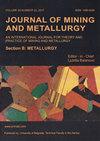Influence of microstructure and crystallographic texture on hydrogen diffusion in IF-steel
IF 1
4区 材料科学
Q3 METALLURGY & METALLURGICAL ENGINEERING
Journal of Mining and Metallurgy Section B-Metallurgy
Pub Date : 2023-01-01
DOI:10.2298/jmmb230201025b
引用次数: 0
Abstract
The relation between microstructure, crystallographic texture and hydrogen diffusion has been studied in an IF-steel. The steel samples were deep drawn until 10%, 20%, 30% and 40% strain levels and then hydrogen diffusion coefficients were determined using Helios II system. Light optical microscope (LOM), scanning electron microscope (SEM) and electron backscatter diffraction (EBSD) were used for microstructural characterization and crystallographic texture studies. The dependence of microstructural parameters was evaluated by Pearson correlation coefficient (PCC) values. Those evaluations showed that local misorientations, crystallographic texture and dislocation density depend on each other. The PCC values show that grain size and dislocation density are the independent microstructure related parameters and those parameters were used to build a model to predict hydrogen diffusion coefficient by multiple linear regression analysis. Using this model sensitivity analysis was also performed to understand which parameter the hydrogen diffusion is most sensitive to. The results of this analysis show that hydrogen diffusion is more sensitive to dislocation density, which indicates that dislocations are more effective trapping sites for hydrogen atoms. On the other hand, grain boundaries are less effective trapping sites since they also provide an additional diffusion mechanism.金相组织和结晶织构对if钢中氢扩散的影响
研究了if钢的显微组织、晶构与氢扩散的关系。将钢试样拉深至10%、20%、30%和40%应变水平,然后利用Helios II系统测定氢扩散系数。采用光学显微镜(LOM)、扫描电镜(SEM)和电子背散射衍射(EBSD)对其进行微观结构表征和晶体织构研究。采用Pearson相关系数(PCC)评价微观结构参数的相关性。这些评价表明,局部取向偏差、晶体织构和位错密度是相互依赖的。PCC值表明,晶粒尺寸和位错密度是与微观结构相关的独立参数,并利用这两个参数建立了多元线性回归模型来预测氢扩散系数。利用该模型进行敏感性分析,了解氢气扩散对哪个参数最敏感。分析结果表明,氢的扩散对位错密度更敏感,这表明位错是更有效的氢原子捕获点。另一方面,晶界是不太有效的捕获点,因为它们也提供了一个额外的扩散机制。
本文章由计算机程序翻译,如有差异,请以英文原文为准。
求助全文
约1分钟内获得全文
求助全文
来源期刊
CiteScore
2.00
自引率
40.00%
发文量
19
审稿时长
2 months
期刊介绍:
University of Belgrade, Technical Faculty in Bor, has been publishing the journal called Journal of Mining and Metallurgy since 1965 and in 1997 it was divided in two independent journals dealing with mining and metallurgy separately. Since 2009 Journal of Mining and Metallurgy, Section B: Metallurgy has been accepted in Science Citation Index Expanded.
Journal of Mining and Metallurgy, Section B: Metallurgy presents an international medium for the publication of contributions on original research which reflect the new progresses in theory and practice of metallurgy. The Journal covers the latest research in all aspects of metallurgy including hydrometallurgy, pyrometallurgy, electrometallurgy, transport phenomena, process control, solidification, mechanical working, solid state reactions, materials processing, surface treatment and relationships among processing, structure, and properties of materials.

 求助内容:
求助内容: 应助结果提醒方式:
应助结果提醒方式:


